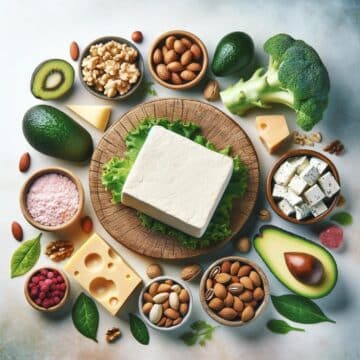It’s no surprise that runners are typically very competitive and self-driven people. They want to do the very best they can in their races, so they try to do the very best they can in their training. Part of making training as effective as possible, in addition to running all the requisite miles and doing all the requisite strength training, is honing in on diet and eating in a way that is supportive of their training goals.
Perhaps it goes without saying, then, that a lot of runners will often do whatever they think will ultimately help them achieve their running goals. For many, that means eating in a particular way -- one that’s probably healthier than that of the average population -- and more often than not, that means eating primarily carbohydrates as a fuel source.
As the ketogenic (or popularly referred to as “keto”) diet has gained popularity over the past few years, naturally many runners have begun to wonder if the keto diet could be supportive of their training and racing goals.
Keto versus carbs for runners?
Admittedly, at first glance, it comes off as completely counterintuitive and asynchronous to running, especially when we consider that for years, runners have been taught to use carbohydrate-rich foods like breads, pastas, and potatoes to fuel their running exploits. Typically speaking, keto adoptees eat primarily fat-rich food as their main source of nutrients and calories (nearly 80%), only about 15% or so from protein, and the balance, anywhere between 0-5% from carbohydrates. The typical keto breakdown flies in the face of the average high carbohydrate diet, which can max out around 60-75% of a runner’s nutritional profile.
The mixed and somewhat nascent science behind keto
Even though keto appears to be gaining traction as a hot new eating trend, the reality is that it has been a diet that has been around for many years but predominantly within the diabetic community. It was only recently that the endurance community’s interest began to be piqued with this dietary trend and with good reason: thanks to the internet and the proliferation of people’s anecdotes that promised great results and feedback, runners, understandably, wanted in.
While the scientific community understands and has documented keto’s implications for diabetics -- namely, that this diet can help alleviate diabetics’ symptoms from their chronic illness -- as yet, there hasn’t been a ton of research on the way that keto affects endurance athletes.
The few studies that have been done have been small in nature and have shown mixed results for endurance athletes. It is far easier for our bodies to burn carbohydrates than it is to burn fats, and while some studies have shown that consuming a keto diet can result in improved body composition, other studies seemed to have revealed that a keto diet can result in poorer aerobic performances, particularly in shorter distances.
The thinking here is that in shorter distances -- such as in 5k races -- runners are pushing their bodies to the well and are attempting to go as hard and fast as they possibly can. When runners are pushing hard, their bodies simply can’t access their fat stores as readily as they can that of their carbohydrates.
In contrast, in ultramarathon distance races, such as 50 miles, because runners are expending energy at a slower rate (and thus, running slower times), their bodies can more readily access their fat-based energy stores.
This is all simply to say that runners will likely have greater performance-based success on keto if they’re training to run ultra-level distances more so than shorter, pure speed-based ones. The science at this point seems to suggest that it’s a matter of energy accessibility, but again, the science is nascent and evolving.
What does this mean for female runners?
When we talk about female runners and their dietary considerations, a few things typically differentiate them from that of their male counterparts. For starters, in general, women need to consume fewer calories per day than males -- at the sedentary level, anyway. When we compare active females to active males, of course active females still need to consume more calories daily than sedentary females, but comparatively speaking, active women will still likely consume fewer calories than men.
Another key differentiating factor for women runners to consider, in regards to their dietary intake, is whether they are pregnant or breastfeeding. Both pregnancy and breastfeeding can profoundly affect a woman’s dietary needs, and this is especially true if the pregnant/breastfeeding woman is also a runner. It would behoove women runners to consult with a registered dietician if they are pregnant/breastfeeding and would like to follow a ketogenic diet simply to ensure that they are doing so safely and in a way that can be supportive of their current state in life.
A final differentiating factor that female runners ought to consider regarding the keto diet is their own history with their iron levels. It’s not uncommon for female runners to struggle with low iron, low ferritin, or even anemia. A sports medicine provider and/or registered dietician can help female runners to ensure their iron and ferritin levels are at a level that is healthy for them and their activity levels. For some female runners, this may mean supplementing with a daily iron pill, and for others, it may mean significantly altering their diet (perhaps in addition to a daily supplement).
Female runners and keto
Because a keto diet is primarily fats-based, ostensibly it may be challenging for female runners to consume a large amount of protein (and thus, iron) from their dietary choices. With that, it follows that their iron and ferritin levels may also be adversely affected by a strict keto diet. This is even more challenging if the female runner is also a vegetarian who wants to take on a keto diet. It’s not to say that it’s impossible; however, a vegetarian keto diet -- particularly for a female runner with a different nutritional profile and needs -- will necessitate additional planning than would a typical keto diet.
In addition, each woman’s monthly menstruation cycle affects her differently. It’s not uncommon for women to divulge that their monthly cycles adversely affect their race performance and training, and some women even continue to suffer from low iron due to both/either footstrike hemolysis and menses. Iron consumption and absorption can all be implicated by menses and hemolysis, so ensuring that female runners are getting appropriate amounts through a keto diet is even more important.
The big picture: what do women runners need to know to be successful on keto?
What do women runners need to know to be successful on a keto diet? First and foremost, I cannot recommend enough that female runners work with a registered dietician to help them understand, plan for, and meet their dietary needs. Working with someone who has pursued higher education in the subject matter and has amassed a number of clinical hours and certified credentialing can be the difference between pursuing this undertaking intelligently or deleteriously.
In particular, if it is possible for a female runner to work with a registered dietician who specializes in athletes, that can further help to ensure that a female runner is being responsible and proactive with her dietary needs.
Perhaps more than anything, what women runners need to know to be successful on keto is simply themselves and their bodies. If female runners have a history with low iron or low ferritin, have dealt with issues surrounding anemia or footstrike hemolysis, or have had issues with disordered eating or orthorexia in the past, a diet like keto -- that could be more restrictive than what the athletes are accustomed to -- may not be a great fit, at least initially.
Additionally, before a female runner begins a keto diet, it’d behoove her to not only talk to a registered dietician about her dietary concerns but also a running coach to address her performance goals. Again, as previously mentioned, if the athletes’ goals are to run a super speedy 5k or 10k race, a ketogenic diet may not adequately provide her body with the readily-available energy she needs come workout days or on race day. In contrast, if the athletes are training for ultra events, learning how to train their bodies to readily access fat energy stores will behoove them, and the keto diet may make a lot of sense.
Conclusion
As the keto diet gains greater popularity and prominence, it follows that more and more athletes, even the everyday weekend warriors among us, may also want to partake in this new way of eating. Because there hasn’t been a lot of extensive research done yet related to runners consuming a keto diet, it’s hard to tell, from any longitudinal point of view, how this way of eating will affect runners over the long-term of their running trajectory.
That said, just as it goes in racing, sometimes it’s worthwhile to take a chance and try something new to see if it’ll positively affect our abilities. As more people run, and as more runners begin to follow a keto diet, we’ll have more information and research at our disposal to make more definitive conclusions. Until then, we’ll simply need to rely on the nascent science and the personal anecdotes to help us arrive at our conclusions about how runners, and in particular women runners, can be successful on the keto diet, both in terms of their nutrition and in terms of their performance.
(This is a guest blog) Author's bio: Jane Grates
Performing at the sweet spot between minimalism and purpose to develop visual solutions that inform and persuade. She also writes reviews and recommendations on Runnerclick, ThatSweetGift, NicerShoes, and GearWeAre.







M says
This article must have been paid by the word because it's a whole lot of nothing, the whole thing boils down to "yes keto is popular and may be good for runners but also may not be don't ask me why are you here? Women get periods and eat less than men."
shell shockers says
Jogging is a very good sport and is good for health
deb says
cool article even for a guy 🙂
i run on keto since 2 years, it's a pleasure, i started both together on my multiple sclerosis, it's gone